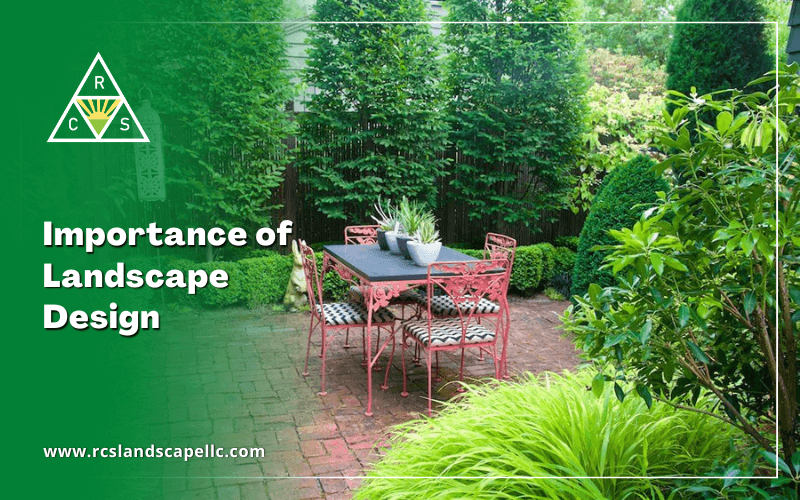The Facts About Landscape Design Revealed
The Facts About Landscape Design Revealed
Blog Article
The 2-Minute Rule for Landscape Design
Table of ContentsThe 7-Minute Rule for Landscape DesignMore About Landscape Design6 Easy Facts About Landscape Design ShownHow Landscape Design can Save You Time, Stress, and Money.
Formal style theme. Credit Score: Gail Hansen, UF/IFAS The yard is an extension of the home where a selection of activities happen. A backyard can normally be separated right into 3 areas: public (the front yard), personal (the backyard), and solution (usually the side yard). The place of activity areas depends mostly on the kind of location, the dimension of room required, the kind of task, and the wanted closeness to other activities and frameworks (Landscape Design).
The outside wall of your home commonly works as the initial wall surface or beginning point of an outside area. Incompatible usages must be separated, and related activities, such as food preparation and eating, ought to be placed together to make the yard a lot more efficient and delightful. When making use of hardscape to develop rooms, use building and construction material comparable to that made use of in your house for continuity from your home into the garden.
Connected areas. Debt: Gail Hansen, UF/IFAS Utilizing comparable hardscape attributes and duplicating plants pulls the eye around the yard.
This supplies a feeling of secret that promotes exploration and discovery of the landscape. From a design viewpoint, plant products have 3 significant functions in the landscape: aesthetic, structural and practical. Visually, plants produce a visually pleasurable setting and structurally plants arrange and define spaces. Plants are utilitarian because they can change the setting for the comfort of the user by changing light, temperature level and humidity.
What Does Landscape Design Mean?
For psychological convenience plants are utilized as physical or suggested barriers for personal privacy and safety. Physical barriers obstruct both the sight and access to an area and include fences, walls and plant hedges. Landscape Design. Suggested barriers, commonly low growing plants, block access however not the sight (Number 9). Other functions of plants consist of cleaning up the air, avoiding erosion and dirt loss, preserving dampness in the dirt, and returning raw material to the soil.
Physical and implied barriers. Credit: Gail Hansen, UF/IFAS For these reasons, the types of plants to be made use of (such as trees, bushes, or groundcovers) should be selected in the beginning of preparation. Plant types are chosen for their useful capabilities so that their future objective and called for area can be taken into consideration at the same time.
The overhead plane, the vertical plane and the ground plane need to all be considered to produce enclosure. Once the form of a plant bed has actually been developed, the plants should be massed (organized) and split to accomplish aesthetic unity and the wanted amount of unit. The size of a plant mass will certainly depend on the overall dimension of the yard, the dimension of the individual plants in the mass, and the focus or impact wanted from the plant material.
Each plant mass is in front of, behind, or following to, an additional mass. Credit Report: Gail Hansen, UF/IFAS Duplicating plants within a mass and repeating masses with comparable plants connects the yard together. The specific plant qualities need to be taken into consideration to successfully layer and mass plants.
The Single Strategy To Use For Landscape Design
All plant great site structures begin with the major structure plants, the huge, mainly evergreen background plants-such as the trees and large hedges. These plants different or enframe areas, manage the size of the room, and give the beginning factor for selecting the suitable characteristics of the 2nd layer, midground plants, for massing and infill.
Crucial points in the yard must be highlighted by the use special plants, distinct structures, or yard ornaments. Noting thresholds or entrances to spaces can be performed with gateways, arbors, and steps, or via making use of special and vivid plants. The kind and/or style motif of the yard will certainly usually help identify the essential factors and just how they need to be highlighted.
Other important locations in the lawn are focal factors, which is utilized to aesthetically organize a landscaped location. Different point of views or point of views can expose different make-ups in the landscape that may require a variety of focal factors.
Landscape Design Fundamentals Explained
Figure 13. Plant forms. Credit Rating: Gail Hansen, UF/IFAS After type, texture is the following leading attribute of a plant; rugged, tool and great textures can be used for comparison and emphasis in the landscape. Type and structure both trump shade in the garden for many of the year. During specific seasons, shade will certainly be the most recognizable characteristic of the garden.


The pleasurable aroma of plants, the noise of wind in the trees, the sound and appearance of check out here water, and the shades and structures of sculptures, pots and garden furnishings all include in the experience of the yard. One detail that is typically overlooked is the result of light on the appearances of the plants.
The whole garden changes in feature and appearance over the course of the day, and the program of a year, as the light and temperature level adjustment from early morning to night and season recommended you read to period. Plant option need to consider a plant's growth price, its fully grown size and form, and the upkeep it will require.
It is necessary to know the ultimate fully grown dimension of plants so they can be placed in the right location and spaced appropriately when they are set up. Offering plants room to grow is an obstacle due to the fact that the common mature size is normally based upon optimal growing problems and the environmental conditions of a website might trigger a plant to expand bigger or stay smaller.
Report this page